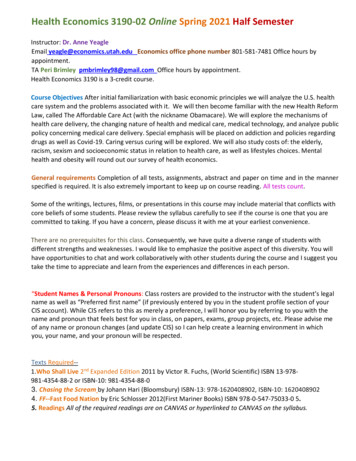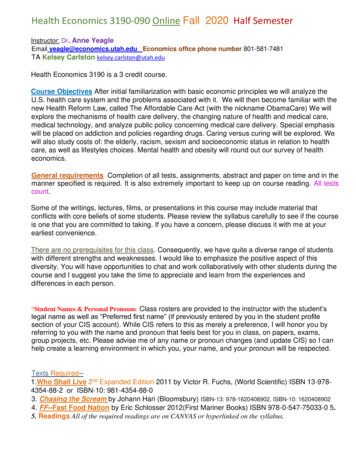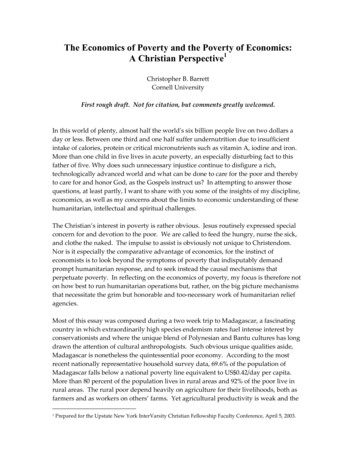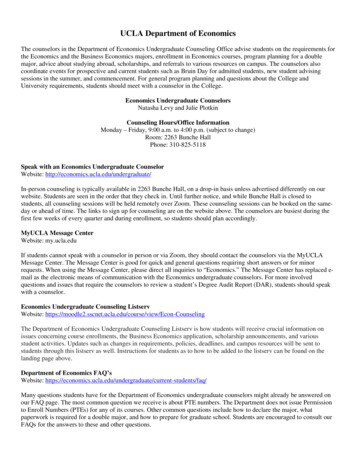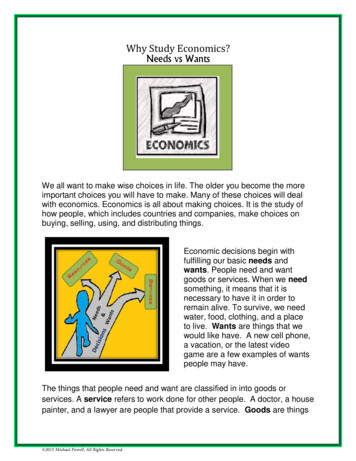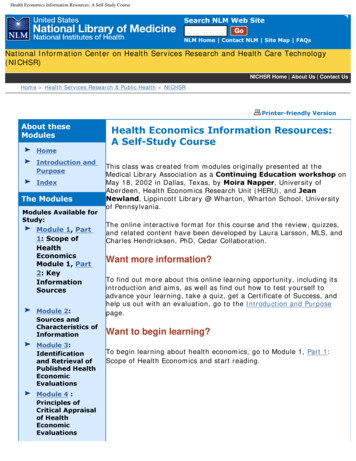
Transcription
Health Economics Information Resources: A Self-Study CourseSearch NLM Web SiteNLM Home Contact NLM Site Map FAQsNational Information Center on Health Services Research and Health Care Technology(NICHSR)NICHSR Home About Us Contact UsHome Health Services Research & Public Health NICHSRPrinter-friendly VersionAbout theseModulesHomeIntroduction andPurposeIndexThe ModulesModules Available forStudy:Module 1, Part1: Scope ofHealthEconomicsModule 1, Part2: KeyInformationSourcesModule 2:Sources andCharacteristics ofInformationModule 3:Identificationand Retrieval ofPublished HealthEconomicEvaluationsHealth Economics Information Resources:A Self-Study CourseThis class was created from modules originally presented at theMedical Library Association as a Continuing Education workshop onMay 18, 2002 in Dallas, Texas, by Moira Napper, University ofAberdeen, Health Economics Research Unit (HERU), and JeanNewland, Lippincott Library @ Wharton, Wharton School, Universityof Pennsylvania.The online interactive format for this course and the review, quizzes,and related content have been developed by Laura Larsson, MLS, andCharles Hendricksen, PhD, Cedar Collaboration.Want more information?To find out more about this online learning opportunity, including itsintroduction and aims, as well as find out how to test yourself toadvance your learning, take a quiz, get a Certificate of Success, andhelp us out with an evaluation, go to the Introduction and Purposepage.Want to begin learning?To begin learning about health economics, go to Module 1, Part 1:Scope of Health Economics and start reading.Module 4 :Principles ofCritical Appraisalof chsr/edu/healthecon/index.html (1 of 2)5/31/2007 4:50:43 AM
Health Economics Information Resources: A Self-Study Course: Module 1Search NLM Web SiteNLM Home Contact NLM Site Map FAQsNational Information Center on Health Services Research and Health Care Technology(NICHSR)NICHSR Home About Us Contact UsHome Health Services Research & Public Health NICHSRPrinter-friendly VersionAbout theseModulesHealth Economics Information Resources: A SelfStudy CourseHomeIntroduction andPurposeIndexThe ModulesModules Available forStudy:Module 1, Part1: Scope ofHealthEconomicsModule 1, Part2: KeyInformationSourcesModule 2:Sources andCharacteristics ofInformationModule 3:Identificationand Retrieval ofPublished HealthEconomicEvaluationsModule 4 :Principles ofCritical Appraisalof HealthEconomicEvaluationsIntroduction and PurposeThis online course: Describes the scope of health economics and its key informationresourcesHighlights the sources and characteristics of health carefinancing information in the U.S.Outlines issues relating to the quality of health economicevaluation studiesGuides users in the identification, retrieval, and assessment ofhigh quality health economic evaluation studies and relatedpublicationsThe purpose of this course is to provide an overviewand discussion of important sources of healtheconomics information so that course participants can: Develop more systematic and effective approaches to itsidentification and retrievalGain greater understanding about its quality and role in healthpolicy formulation and decision-makingCourse StructureThe course is presented in four modules, listed below.Learners should begin with Module 1 and progresslinearly through the modules in order to maximize thehttp://www.nlm.nih.gov/nichsr/edu/healthecon/00 he intro.html (1 of 4)5/31/2007 4:51:48 AM
Health Economics Information Resources: A Self-Study Course: Module 1Related Content:Glossary ofTermsKey GeneralEconomicsConceptsBibliographylearning of this concept.Module 1 - The Scope of Health Economics and KeyInformation SourcesModule 1 is divided into two parts: Web SitesQuizzes/Review EvaluationContact UsPart 1 - Outlines the scope of health economics and andincludes the Williams' model of the Structure of HealthEconomicsPart 2 - Outlines and highlights the type of information whichmay be required for health economics and where to find itModule 2 - Sources and Characteristics of InformationRelating to Health Care Financing in the USMaterial for this module was prepared by Jean Newland,Librarian, Wharton School, University of Pennsylvania. Itcontains information on sources of information relatingto health care financing in the United States.Module 3 - Identification and Retrieval of HealthEconomic EvaluationsModule 3 presents an effective approach to systematicsearching of published health economic evaluationstudies by: Explaining the definition and purpose of economic evaluationstudiesHighlighting the characteristics of the health economicevaluation literatureExamining how economic evaluation studies are indexed in thetwo major bibliographic databases, MEDLINE and EMBASEModule 4 - Principles of Critical Appraisal of HealthEconomic EvaluationsModule 4 provides an introductory guide to qualityappraisal of published health economic evaluationstudies by: Explaining why appraisal is requiredExplaining each of the key areas to consider in the criticalappraisal of health economic evaluation studiesProviding an appraisal of a selected paper Appraised Paper Case Study - An economic evaluation of thrombolysis inthe con/00 he intro.html (2 of 4)5/31/2007 4:51:48 AM
Health Economics Information Resources: A Self-Study Course: Module 1Additional ContentA glossary of health economics and related terms is provided for youruse and links have been made to appropriate terms. A list of Websites and a Bibliography for improving access to health economicsinformation is also linked for viewing.A Glossary - A valuable glossary of terms is included with hypertextlinks from the text to the terms.List of Web sites - Useful Web sites that you can go to for additionalinformation.Bibliography - Citations used in the compilation of this learning.Key General Economics Concepts - A few key economicsconcepts not covered in these modules but relevant to anunderstanding of health economics are included in a separate, optionalsection. No concepts from the Key Health Economics Concepts will beused in the quizzes.Additional InformationUsing the LearningThis online course has been designed to work with Microsoft InternetExplorer version 4 and Netscape version 4 .The course includes two different types of links that may be used toview glossary terms, or visit another Web page.Words and phrases that appear in bold blue are glossary items. Putyour mouse over the term to view a definition. You can also click thelink to visit the definition in the full glossary. You may view the entireGlossary by selecting the Glossary link in the course sidebar.Words and phrases that appear in blue and are underlined, are links toweb sites such as other pages of the course or to other sites. Visitedlinks are red.To return to the beginning of this course, click on the Home Page linkthat appears in the Menu bar.Learning as You Go: Testing YourselfMany pages have a link at the bottom of the page called: TestYourself. A question based on the content that appeared on 0 he intro.html (3 of 4)5/31/2007 4:51:48 AM
Health Economics Information Resources: A Self-Study Course: Module 1page will appear. After answering the question. click the Return toLesson link and Next at the bottom of the screen to continue on inthe module.Quizzes, Evaluations and the Certificate of SuccessAt the end of each module you may elect to try the quiz associatedwith that module's content. You must take the quiz and get 7 correctout of 10 questions correct in order to get the Certificate of Successfor that module. (You may retake each of the quizzes as many timesas you like).The Certificate is intended to be printed on a color printer, but youmay also use a black and white printer as easily.When you have completed each module we invite you to give usfeedback via the online evaluation form. We will use this informationto improve this and other learning opportunities.PreviousLast reviewed: 13 June 2006Last updated: 13 June 2006First published: 08 December 2003Metadata Permanence level: Permanent: Dynamic ContentCopyright, Privacy, AccessibilityU.S. National Library of Medicine, 8600 Rockville Pike, Bethesda, MD 20894National Institutes of Health, Health & Human on/00 he intro.html (4 of 4)5/31/2007 4:51:48 AMNext
Health Economics Information Resources: A Self-Study CourseSearch NLM Web SiteNLM Home Contact NLM Site Map FAQsNational Information Center on Health Services Research and Health Care Technology(NICHSR)NICHSR Home About Us Contact UsHome Health Services Research & Public Health NICHSRPrinter-friendly VersionAbout theseModulesHealth Economics Information Resources: A SelfStudy CourseHomeIntroduction andPurposeIndexThe ModulesModules Available forStudy:Module 1, Part 1:Scope of HealthEconomicsModule 1, Part 2:Key InformationSourcesModule 2:Sources andCharacteristics ofInformationModule 3:Identificationand Retrieval ofPublished HealthEconomicEvaluationsModule 4:Principles ofCritical Appraisalof HealthEconomicEvaluationsRelated Content:Glossary of Frequently Encountered Terms inHealth EconomicsNote: Additional key general economics concepts canbe found elsewhere in this learning opportunity.Access to Health Care1) The degree to which individuals are inhibited orfacilitated in their ability to gain entry to and to receivecare and services from the health care system. Factorsinfluencing this ability include geographic, architectural,transportational, and financial considerations, amongothers. (MeSH uses the term 'Health Services Accessibility'.2) Entry [to the health care system] is dependent on thewants, resources, and needs that individuals bring to thecare-seeking process. Ability to obtain wanted or neededservices may be influenced by many factors, includingtravel distance, waiting time, available financial resources,and availability of a regular source of care. (Turnock, 2001)Allocative EfficiencyAssesses competing programs and judges theextent to which they meet objectives. Anallocation of resources such that no change inspending priorities could improve the welfareof one person without reducing the welfare ssary.html (1 of 26)5/31/2007 7:14:38 AM
Health Economics Information Resources: A Self-Study CourseGlossary of TermsKey GeneralEconomicsConceptsBibliographyWeb SitesQuizzes/Reviewanother.Attitude to HealthPublic attitudes toward health, disease, and themedical care system. (MeSH)Average Cost - see CostEvaluationContact UsBenefitThe sum (usually expressed in money terms to make itcommensurate with cost) of the effects on well-being(positive or negative) which a particular program bestowsupon society. NB. as with costs, all benefits, anddisbenefits, which result from a particular program areconsidered relevant, regardless of who gains them. Someof these benefits, such as relief of pain or suffering, arereferred to as 'intangible'. These are difficult to quantifybut attempts have been made to value them using forexample, QALYs or the willingness-to-pay approach.BenefitsThe dollar amount available for the cost of coveredmedical services.BeneficiaryAny person, either a subscriber or a dependent, eligible forservice under a health plan.Blue Cross/Blue ShieldA combined medical plan offered through a worker’s placeof employment that combines both hospital and physiciancoverage.CapitationA fixed amount of payment per patient, per year,regardless of the volume or cost of services each patientrequires.Clinical Effectiveness.The application of interventions which have been shownto be efficacious to appropriate patients in a timely n/glossary.html (2 of 26)5/31/2007 7:14:38 AM
Health Economics Information Resources: A Self-Study Courseto improve patients' outcomes and value for the use ofresources (Batstone, 1996).Controlled Vocabulary (Librarianship)Specific words and phrases (descriptors) used whencreating subject headings for a book, article, etc. for aspecific index or catalog. (Riverside)Co-payments (Co-pay, user charge)A fixed dollar payment that is made by the patient to theprovider at the time of service. (Glossary)Consumer BehaviorThe observable behavior that a health care consumer doeswhen deciding to acquire health care.Consumer Expenditure SurveyCollects current consumer expenditure data, which providea continuous flow of data on the buying habits of theAmerican consumers.Consumer Price Index (CPI)Prepared by the U.S. Bureau of Labor Statistics, it is amonthly measure of the average change in the prices paidby urban consumers for a fixed market basket of goodsand services. The medical care component of CPI showstrends in medical care prices based on specific indicatorsof hospital, medical, dental, and drug prices.Controlled Vocabulary (Librarianship)A means of searching a resource using words or termsselected by the creator of a resource or by an organizationor individual other than the user of the resource. Incontrast to a keyword, which can be any word or termselected by the user of the resource. Searching a resourceusing controlled vocabulary is usually more precise andfocused than searching by keyword. (University ofWisconsin)CostThe economic definition of cost (also known as opportunitycost) is the value of opportunity forgone, strictly the lossary.html (3 of 26)5/31/2007 7:14:38 AM
Health Economics Information Resources: A Self-Study Courseopportunity forgone, as a result of engaging resources inan activity. Note that there can be a cost without theexchange of money. Also the economists' notion of costextends beyond the cost falling on the health servicealone, e.g., includes costs falling on other services and onpatients themselves.In considering the production process, costs may bedifferentiated as follows: Average costs - equivalent to the average cost per unit; i.e.,the total costs divided by the total number of units of production.Fixed costs - those costs which, within a short time span, donot vary with the quantity of production; e.g., heating andlighting.Incremental cost - the extra costs associated with anexpansion in activity of a given service.Marginal cost - the cost of producing one extra unit of aservice.Total costs - all costs incurred in the production of a setquantity of service.Variable costs - those costs which vary with the level ofproduction and are proportional to quantities produced.In considering health problems, costs may bedifferentiated as follows: Avoided costs - costs caused by a health problem or illnesswhich are avoided by a health care intervention.Direct costs - those costs borne by the healthcare system,community and patients' families in addressing the illness.Indirect costs - mainly productivity losses to society caused bythe health problem or disease.Cost AllocationThe assignment, to each of several particular cost-centers,of an equitable proportion of the costs of activities thatserve all of them. Cost-center usually refers to institutionaldepartments or services. (MeSH)Cost AnalysisAnalysis of the comparative costs of alternativeinterventions or programs. Does not includeconsequences. (Drummond)Cost-benefit Analysis (CBA)An economic evaluation in which all costs ossary.html (4 of 26)5/31/2007 7:14:38 AM
Health Economics Information Resources: A Self-Study Courseconsequences of a program are expressed in the sameunits, usually money. CBA is used to determine allocativeefficiency; i.e., comparison of costs and benefits acrossprograms serving different patient groups. NB. Even ifsome items of resource or benefit cannot be measured inthe common unit of account; i.e., money, they should notbe excluded from the analysis.Cost ComparisonCost comparison compares only the costs of two or moreinterventions or programs. (Zarnke)Cost ControlThe containment, regulation, or restraint of costs. Costsare said to be contained when the value of resourcescommitted to an activity is not considered excessive. Thisdetermination is frequently subjective and dependent uponthe specific geographic area of the activity beingmeasured. (Dictionary)Cost DescriptionExamines the costs of a single intervention or program.Does not include the consequences of the intervention andno comparison is made with an alternative intervention.(Zarnke)Cost-effectivenessThe point at which the minimum amount of input (andtherefore cost) is used to achieve a given output.Cost-effectiveness Analysis (CEA)An economic evaluation in which the costs andconsequences of alternative interventions are expressedcost per unit of health outcome. CEA is used to determinetechnical efficiency; i.e., comparison of costs andconsequences of competing interventions for a givenpatient group within a given budget. See also TechnicalEfficiencyCost-minimization Analysis (CMA)An economic evaluation in which consequencesof competing interventions are the same and ssary.html (5 of 26)5/31/2007 7:14:38 AM
Health Economics Information Resources: A Self-Study Coursewhich only inputs, that is, costs are taken intoconsideration. The aim is to decide the leastcostly way of achieving the same outcome.Cost of IllnessThe personal cost of acute or chronic disease. The cost tothe patient may be an economic, social, or psychologicalcost or personal loss to self, family, or immediatecommunity. The cost of illness may be reflected inabsenteeism, productivity, response to treatment, peaceof mind, QUALITY OF LIFE, etc. It differs from HEALTHCARE COSTS, meaning the societal cost of providingservices related to the delivery of health care, rather thanpersonal impact on individuals. (MeSH)Cost of Illness StudyAims to identify and measure the total costs attributableto a particular disease. These are not a type of economicevaluation as they are not used to assess the costs andbenefits of alternative interventions or programs. Theymay provide useful information which can be used in thecontext of an economic evaluation of interventions relatedto the disease category, although care must be taken asnot all costs included in a cost of illness study representresource costs (Donaldson). Cost of illness studies mayalso be utilized in the estimation of the economic burdenof disease.Cost Outcome DescriptionDescribes the costs and consequences of a singleintervention or program. No comparison is made with analternative intervention. (Zarnke)Cost SharingProvisions of an insurance policy that require the insuredto pay some portion of covered expenses. Several forms ofsharing are in use, e.g., deductibles, coinsurance, andcopayments. Cost sharing does not refer to or includeamounts paid in premiums for the coverage. (Dictionary)Cost-utility Analysis (CUA)A form of economic study design in which interventionswhich produce different consequences, in terms of bothquantity and quality of life, are expressed as 'utilities'.These are measures which comprise both length of life ossary.html (6 of 26)5/31/2007 7:14:38 AM
Health Economics Information Resources: A Self-Study Coursesubjective levels of well being. The best known utilitymeasure is the 'quality adjusted life year' or QALY. In thiscase, competing interventions are compared in terms ofcost per utility (cost per QALY). See also QualityAdjusted-Life-Year.Costs and Cost AnalysisAbsolute, comparative, or differential costs pertaining toservices, institutions, resources, etc., or the analysis andstudy of these costs. (MeSH)Decision-MakingThe process of making a selective intellectual judgmentwhen presented with several complex alternativesconsisting of several variables, and usually defining acourse of action or an idea. (MeSH)Deductible (excess)A fixed dollar amount that the patient must pay beforereimbursement begins; in most indemnity plans there isno separate deductible for drugs. (Glossary)Direct Service CostsCosts which are directly identifiable with a particularservice. (MeSH)DiscountingA technique which allows the calculation of present valuesof inputs and benefits which accrue in the future.Discounting is based on a time preference which assumesthat individuals prefer to forego a part of the benefits ifthey accrue it now, rather than fully in the uncertainfuture. By the same reasoning, individuals prefer to delaycosts rather than incur them in the present. The strengthof this preference is expressed by the discount rate whichis inserted in economic evaluations.Drug ApprovalUsed for investigational new drug application. (Emtree)Drug CostsThe amount that a health care institution or thecon/glossary.html (7 of 26)5/31/2007 7:14:38 AM
Health Economics Information Resources: A Self-Study Coursepays for its drugs. It is one component of the final pricethat is charged to the consumer (FEES, PHARMACEUTICALor PRESCRIPTION FEES). (MeSH)Note: EMBASE uses Drug Cost (singular)Drug FormularyA list of drugs, usually by their generic names, andindications for their use. A formulary is intended to includea sufficient range of medicines to enable physicians,dentists, and, as appropriate, other practitioners toprescribe all medically appropriate treatment for allreasonably common illnesses. (AcademyHealth)Drug UtilizationDrug prescription and use patterns.Economic Appraisal - see Economic evaluationEconomic Burden of Disease, see Cost of IllnessEconomic CompetitionThe effort of two or more parties to secure the business ofa third party by offering, usually under fair or equitablerules of business practice, the most favorable terms.Economic EvaluationThe systematic appraisal of costs and benefits of projects,normally undertaken to determine the relative economicefficiency of programs. See Cost-benefit analysis, Costeffectiveness analysis, Cost-minimization analysis,Cost-utility analysis.Economic Value of Life - see Value of LifeEconomic Value TheoryThe intrinsic worth of a commodity. If defined in terms ofmoney, value determines price. It is traditional to separatethe concepts of use value and value in exchange. Value inuse is not an intrinsic quality of a commodity, but itscapacity to satisfy human wants. Value in exchange is theworth of commodity in terms of its capacity to beexchanged for another commodity. In classical economicsthe existence of use value was a prerequisite ossary.html (8 of 26)5/31/2007 7:14:38 AM
Health Economics Information Resources: A Self-Study Coursecommodities to have value in exchange. A commoditymust possess UTILITY or usefulness in order for it to beproduced or exchanged. (adapted from the MacmillanDictionary of Modern Economics. 4th edition. Basingstoke.Macmillan. 1992)Economics(1) The science of utilization, distribution, andconsumption of services and materials. (MeSH)(2) The study of how individuals and societies choose toallocate scarce productive resources among competingalternative uses and to distribute the products from theseuses among members of the society. (World Bank, 2001)EffectivenessThe contribution which a program makes to individuals'utility or welfare, normally through better health, but notnecessarily solely through better health.EfficiencyMaking the best use of available resources; i.e.getting good value for resources. See alsoAllocative efficiency and Technicalefficiency.Employer Health CostsThat portion of total HEALTH CARE COSTS borne by anindividual's or group's employing organization. (MeSH)EpidemiologyThe study of the distribution of determinants andantecedents of health and disease in human populations;the ultimate goal is to identify the underlying causes of adisease, then apply findings to disease prevention andhealth promotion. (Turnock, 2001)EquityThe degree to which some distribution or other is judgedto be 'fair'. 'Fairness' involves a value judgment so; e.g.,'greater equality' need not imply 'greater on/glossary.html (9 of 26)5/31/2007 7:14:38 AM
Health Economics Information Resources: A Self-Study CourseExternalitiesThese are negative or positive utilities accruing to anindividual from another person's consumption. Forexample, if the majority of a community is vaccinatedagainst an infectious disease, the resulting herd immunitybenefits those who have not been vaccinated.Fees and ChargesFee: A charge for a service rendered. (World Bank 2001)Charge: The amount asked for a service by a health careprovider. Its contracted with the cost, which is amount theprovider incurs in furnishing the service. It is difficult todetermined precise costs for many services, and in suchcases charges are substituted for costs in manyreimbursement or payment formulas (often with thestipulation that the hospital’s bookkeeping follow certainrules). (World Bank 2001)Finance1) As a broad managerial field, finance is the art orscience of obtaining and managing funds.2) The manipulation of money and credit; the fields ofbanking, taxes, and insurance, and the money, foreignexchange, and investment markets. Finance directlyinvolves other fields such as accounting, marketing, andproduction. It is an integral part of management in allthree sectors of the economy (i.e., the private, non-profit,and public sectors). (Rhea)Financial ManagementThe obtaining and management of funds for institutionalneeds and responsibility for fiscal affairs.FinancingIn health care finance, these are the methods of gaining,and the sources of, revenue in health services. Modes offinancing include third-party payers, public grants,contracts with managed care, government contracts,direct public/government payment for service,philanthropic grants and payments for service, loans,bonds and self-pay.Financing, con/glossary.html (10 of 26)5/31/2007 7:14:38 AM
Health Economics Information Resources: A Self-Study CourseAll organized methods of funding. (MeSH)Full Economic EvaluationFull economic evaluations are studies in which acomparison of two or more treatments or care alternativesis undertaken and in which both the costs and outcomes ofthe alternatives are examined. See also, Cost-benefitanalysis (CBA), Cost-effectiveness analysis (CEA),andCost-utility analysis (CUA).GREATGrampian Region Early Anistreplase Trial (GREAT). This isa single study randomized controlled trial. The study wasmulti-centered covering 29 rural general practices and onehospital. The follow-up period was four years. No loss tofollow-up was reported.Gross Domestic Product (GDP)GDP is the market value of the goods and servicesproduced by labor and property located in the UnitedStates. A barometer of the U.S. economy, it illustrates thepace at which the economy is growing or shrinking.Gross National Product (GNP)The market value of all final goods and services producedin a given time period (usually one year) by the nationalsof a country residing either in the country or abroad.(Glossary)Health Care CostsThe actual costs of providing services related to thedelivery of health care, including the costs of procedures,therapies, and medications. It is differentiated fromHEALTH EXPENDITURES, which refers to the amount ofmoney paid for the services, and from fees, which refersto the amount charged, regardless of cost. (MeSH)Note: Embase uses Health Care Cost (singular)Health Care Financing - see FinancingHealth Care Markets - See Health Care SectorHealth (Care) /glossary.html (11 of 26)5/31/2007 7:14:38 AM
Health Economics Information Resources: A Self-Study CourseDecisions, usually developed by government policymakers,for determining present and future objectives pertaining tothe health care system. (MeSH)Health Care ReformInnovation and improvement of the health care system byreappraisal, amendment of services, and removal of faultsand abuses in providing and distributing health services topatients. It includes a re-alignment of health services andhealth insurance to maximum demographic elements (theunemployed, indigent, uninsured, elderly, inner cities,rural areas) with reference to coverage, hospitalization,pricing and cost containment, insurers' and employers'costs, pre-existing medical conditions, prescribed drugs,equipment, and services. (MeSH)Health Care SectorEconomic sector concerned with the provision, distribution,and consumption of health care services and relatedproducts. (MeSH)Health Care RationingPlanning for the equitable allocation, apportionment, ordistribution of available health resources.Health Care Utilization - see UtilizationHealth EconomicsThe study of how scarce resources are allocated amongalternative uses for the care of sickness and thepromotion, maintenance and improvement of health,including the study of how healthcare and health-relatedservices, their costs and benefits, and health itself aredistributed among individuals and groups in society.(World Bank 2001)Health ExpendituresThe amounts spent by individuals, groups, nations, orprivate or public organizations for total health care and/orits various components. These amounts may or may notbe equivalent to the actual costs (HEALTH CARE COSTS)and may or may not be shared among the patient,insurers, and/or employers. /glossary.html (12 of 26)5/31/2007 7:14:38 AM
Health Economics Information Resources: A Self-Study CourseHealth InequalitiesThe gap in health status, and in access to health services,between different social classes and ethnic groups andbetween popu
Health Economics Information Resources: A Self-Study Course: Module 1 Additional Content A glossary of health economics and related terms is provided for your use and links have been made to appropriate terms. A list of Web sites and a Bibliography for improving access to


